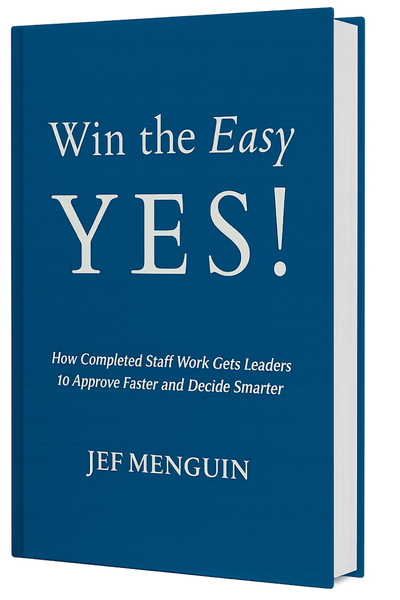What if your staff gave you answers, not just questions?
Welcome to Completed Staff Work (CSW)—a game-changer for Filipino supervisors, government officials, and managers who are tired of firefighting and ready to lead with clarity, confidence, and results.
Completed Staff Work is not about being busy. It’s about being brilliant.
It’s a process where staff members do the hard thinking, the deep digging, and the sharp analyzing before bringing anything to the boss. So when a decision hits the desk, it’s not half-baked. It’s good to go.
What is Completed Staff Work?
Ever received a report that left you with more questions than answers?
That’s not Completed Staff Work.
That’s incomplete thinking disguised as paperwork. And let’s be honest—wala siyang silbi.
Completed Staff Work (CSW) is this:
It’s when your staff doesn’t just raise a problem—they raise a solution. A clear, actionable recommendation that’s ready for your signature.
No guesswork. No back-and-forth. No “Boss, what do you want me to do?”
Instead, you get:
“Here’s the problem. Here are three options. I recommend Option B—and here’s why.”
Now that is Completed Staff Work.
Let’s break it down.
Completed Staff Work is a mindset.
It’s also a method.
It’s how leaders train their teams to think critically, plan thoroughly, and deliver work that’s ready for execution—not just discussion.
The golden rule? The only thing the boss should have to do is approve it.
If your staff gives you work that still needs your brainpower to fix, it’s not complete.
Where did CSW come from?
It began in the military—where lives depended on solid decisions, made fast. Officers couldn’t waste time solving problems their staff should’ve already solved.
So they developed a system:
Don’t send the problem up unless it’s wrapped in a solution.
This concept was formalized during World War II, especially in the U.S. Army. The idea was simple but powerful: Staff officers had to submit reports that required no further work—just a signature. It was designed to develop independent thinkers and confident decision-makers.1
Today, we bring that same discipline into the workplace. Whether you’re leading a government office or managing a corporate team, CSW helps you avoid delay, confusion, and endless revisions.
Why it matters—especially in the Philippines.
In many Filipino workplaces, it’s still common to “ask the boss” every step of the way.
But that slows things down. It overloads leaders. And it kills initiative.
CSW flips that.
It empowers staff to own their work, and frees leaders to lead.
Imagine a culture where:
- Employees present clear, well-thought-out proposals.
- Meetings are shorter because decisions are easier.
- Leaders trust that the thinking has already been done.
Now imagine doing this consistently.
Why Completed Staff Work Works
- Inquiry over impulse. You don’t react; you investigate.
- Ownership over obligation. Staff stop asking “What do I do?” and start showing “Here’s what we’ll do.”
- Execution over excuses. No more back-and-forth emails or meetings that could’ve been memos. CSW makes things happen.
Big Wins from Completed Staff Work
- Better decisions. Because they’re based on real data, not gut feel.
- Faster execution. Because everything’s already been figured out.
- Higher trust. Between boss and staff. Between team members. Between you and results.
The CSW Mindset
Completed Staff Work is more than a technique. It’s a culture. A mindset. A quiet revolution.
When people learn it, they stop passing the buck. They take responsibility. They think like leaders.
And when leaders practice it, they stop micromanaging. They start making decisions that move the needle.
The Science Behind It
The benefits of Completed Staff Work aren’t just anecdotal—they’re backed by science.
- A 2017 study in the Harvard Business Review showed that teams empowered to make recommendations (not just report problems) improved decision speed by 38%.
- Research from McKinsey & Company found that organizations that promote analytical thinking in decision-making are 2x more likely to outperform their peers.
- Google’s Project Aristotle revealed that psychological safety—created when teams feel ownership and clarity—was the number one factor in high-performing teams. CSW builds this by giving team members responsibility, not just tasks.
So, when we say CSW works—we’re not just saying it. The numbers agree.. It’s a culture. A mindset. A quiet revolution.
When people learn it, they stop passing the buck. They take responsibility. They think like leaders.
And when leaders practice it, they stop micromanaging. They start making decisions that move the needle.
The 12 Stages of Completed Staff Work
This hub is your jump-off point. These 12 steps are where the magic—and the transformation—happens.
But before we dive into the how, let’s acknowledge the what: the everyday problems that drag teams down.
Each step below solves a common issue that every Filipino supervisor or government officer has faced. The kind that slows progress, frustrates leaders, and wastes precious oras.
Here’s how CSW tackles those headaches one by one:
- Define the End Game – Most teams start with action, not clarity. And when there’s no clear finish line, everyone just keeps running in circles. This step brings focus, alignment, and a shared picture of success.Know exactly what success looks like. For you, for the boss, for the whole barangay.
- Identify the Real Problem – We often waste time fixing symptoms while the real problem hides beneath the surface. This step teaches teams to dig deeper and stop chasing the wrong issues.Don’t treat symptoms. Cure the disease.
- Build Team Accountability – When roles are unclear, blame gets passed around like hot potato. This step creates ownership and makes sure everyone knows what they’re responsible for—and why it matters.No more hiding behind vague roles.
- Do the Legwork, Dig Deep – Shallow research leads to shallow solutions. This step arms your team with the discipline to find real data, spot patterns, and uncover insights that actually move the needle.Research like a journalist with a deadline.
- Think in Options, Not Just Answers – Staff often come with one idea, expecting a yes or no. This step trains them to think strategically—offering real choices and letting the boss decide from strength, not pressure.Give your boss choices, not chores.
- Be Your Own Toughest Critic – Many staff submit work that hasn’t been tested under pressure. This step shows how to anticipate objections, stress-test ideas, and catch the cracks before anyone else does.Better you find the holes than your boss.
- Ensure Clarity and Flow – Even brilliant ideas fall flat if they’re hard to follow. This step is about making your message punchy, persuasive, and painfully clear.Confusing reports kill good ideas. Clarity sells.
- Write the Memo – Some people write to impress, not to inform. This step focuses on creating a sharp, decision-ready document that your boss can read, understand, and act on—fast.Make it short. Make it sharp. Make it decision-ready.
- Cut the Fluff – Long-winded reports waste everyone’s time. This step trains your team to write with precision and power, stripping away anything that doesn’t serve the goal.If it doesn’t help the boss decide, it doesn’t belong.
- Use Visuals for Impact – If it takes a paragraph to explain a simple idea, you’re losing people. This step shows how to use charts, diagrams, and visuals that simplify complexity and speed up decision-making.Show, don’t just tell.
- Present with Confidence – Even a solid plan can fall apart if delivered with doubt. This step builds presence, clarity, and the readiness to defend your work without being defensive.Own your work. Be ready to defend it.
- Evaluate and Elevate – Most teams move on without learning. This step is about taking time to reflect, get feedback, and level up so the next project runs even smoother.Learn. Improve. Level up.
Each article in this series breaks down a step, gives real-world examples, and arms you with simple tools you can use right away. Whether you’re in a government office in Quezon City or managing a team in Davao, these steps will help you work smarter.
Ready to stop reacting and start leading?
Dive into the first stage: Define the End Game.
You’re not here to do average work. Neither is your team.
Let’s bring out the brilliance in both.
Ready to Go Deeper?
We’ve got resources to help you master Completed Staff Work and build a culture of ownership and excellence in your team:
- Join our 4-week public seminar series – Half-day sessions packed with practical tools, real examples, and high-impact strategies. Perfect for Filipino supervisors and government professionals who want results fast.
- Subscribe to the 30-Day MVP Newsletter – Daily emails with short lessons, actionable tips, and quick wins you can apply immediately. Think of it as your daily CSW playbook.
- Follow me on LinkedIn – Stay connected, get inspired, and learn from a community of leaders who are applying CSW every day.
- Watch out for our upcoming online course – Soon, you’ll be able to learn Completed Staff Work anytime, anywhere. We’re building something powerful—stay tuned!
You don’t have to do this alone. We’re here to support your journey every step of the way.
CSW Articles
I’ve written several other articles on Completed Staff Work that delve deeper into various aspects of the process. These articles cover topics such as effective research techniques, critical analysis methods, and best practices for presenting your findings. Exploring these resources can provide you with a comprehensive understanding and additional tools to master CSW.
I encourage you to check them out to further enhance your skills and knowledge. Each article is designed to offer practical insights and actionable tips to help you excel in your role. Happy reading!
- Source: U.S. War Department Field Manual 101-5, 1940. Officers couldn’t waste time solving problems their staff should’ve already solved. ↩︎







